The Impacts of Bedding Strength Parameters on the Micro-Cracking Morphology in Laminated Shale under Uniaxial Compression
Abstract
Featured Application
Abstract
1. Introduction
2. Microstructure of Laminated Shale Specimen and Micro-Constitutive Models
2.1. Geometric Model and Loading Parameters
2.2. Micro-Constitutive Model for Rock Matrix
2.3. Micro-Constitutive Model for Bedding
2.4. Complexity Measure of Micro-Cracking Morphology
3. Comparison of Numerical Simulations with Laboratory Measurements
3.1. Experiments in Uniaxial Compression
3.2. Determination of Micro-Parameters
4. Micro-Cracking Behaviors of Shale under Different Bedding Parameters
4.1. Effects of Bedding Strength
4.1.1. Stress-Strain Responses and Micro-Crack Evolution
4.1.2. Change of Crack Types
4.1.3. Micro-Cracking Morphology
4.2. Effects of Shear-to-Tensile Strength Ratio of Beddings
4.2.1. Stress-Strain Responses and Micro-Cracking Evolution
4.2.2. Changes of Crack Type
4.2.3. Micro-Cracking Morphology
4.3. The Difference Between Bedding Strength and Its Shear-to-Tensile Strength Ratio
5. Conclusions
Author Contributions
Funding
Acknowledgments
Conflicts of Interest
References
- Cho, J.W.; Kim, H.; Jeon, S.; Min, K.B. Deformation and strength anisotropy of Asan gneiss, Boryeong shale, and Yeoncheon schist. Int. J. Rock Mech. Min. Sci. 2012, 50, 158–169. [Google Scholar] [CrossRef]
- Fjaer, E.; Nes, O.M. Strength anisotropy of Mancos shale. In Proceedings of the 47th US Rock Mechanics Symposium, San Francisco, CA, USA, 23–26 June 2013. [Google Scholar]
- Yang, X.X.; Jing, H.W.; Qiao, W.G. Numerical investigation of the failure mechanism of transversely isotropic rocks with a particle flow modeling method. Processes 2018, 6, 171. [Google Scholar] [CrossRef]
- Wei, J.; Niu, L.L.; Song, J.J.; Xie, L.M. Estimation of rock tensile and compressive moduli with Brazilian disc test. Geomech. Eng. 2019, 19, 353–360. [Google Scholar]
- Pietruszczak, S.; Mroz, Z. Formulation of anisotropic failure criteria incorporating a microstructure tensor. Comput. Geotech. 2000, 26, 105–112. [Google Scholar] [CrossRef]
- Pietruszczak, S.; Lydzba, D.; Shao, J.F. Modelling of inherent anisotropy in sedimentary rocks. Int. J. Solids Struct. 2002, 39, 637–648. [Google Scholar] [CrossRef]
- Lee, Y.K.; Pietruszczak, S. Application of critical plane approach to the prediction of strength anisotropy in transversely isotropic rock masses. Int. J. Rock Mech. Min. Sci. 2008, 45, 513–523. [Google Scholar] [CrossRef]
- Shi, X.C.; Yang, X.; Meng, Y.F.; Li, G. An anisotropic strength model for layered rocks considering planes of weakness. Rock Mech. Rock Eng. 2016, 49, 3783–3792. [Google Scholar] [CrossRef]
- Chong, Z.H.; Li, X.H.; Hou, P.; Wu, Y.C.; Zhang, J.; Chen, T.; Liang, S. Numerical investigation of bedding plane parameters of transversely isotropic shale. Rock Mech. and Rock Eng. 2017, 50, 1183–1204. [Google Scholar] [CrossRef]
- Khanlari, G.; Rafiei, B.; Abdilor, Y. Evaluation of strength anisotropy and failure modes of laminated sandstones. Arab. J. Geosci. 2015, 8, 3089–3102. [Google Scholar] [CrossRef]
- Chen, J.H.; Lan, H.X.; Macciotta, R.; Wu, Y.M.; Li, Q.W.; Zhao, X.X. Anisotropy rather than transverse isotropy in Longmaxi shale and the potential role of tectonic stress. Eng. Geol. 2018, 247, 38–47. [Google Scholar] [CrossRef]
- Liu, B.; Yang, Y.Q.; Li, J.T.; Chi, Y.A.; Li, J.H.; Fu, X.F. Stress sensitivity of tight reservoirs and its effect on oil saturation: A case study of Lower Cretaceous tight clastic reservoirs in the Hailar Basin, Northeast China. J. Pet. Sci. Eng. 2020, 184, 106484. [Google Scholar] [CrossRef]
- Guo, W.; Shen, W.J.; Li, X.Z.; Wang, N.; Liu, X.H.; Zhang, X.W.; Zhou, S.W. Study on mechanical characteristics and damage mechanism of the Longmaxi Formation shale in southern Sichuan Basin, China. Energy Explor. Exploit. 2020, 38, 454–472. [Google Scholar] [CrossRef]
- Liu, J.; Liang, X.; Xue, Y.; Fu, Y.; Yao, K.; Dou, F.K. Investigation on crack initiation and propagation in hydraulic fracturing of bedded shale by hybrid phase-field modeling. Theor. Appl. Fract. Mech. 2020, 108, 102651. [Google Scholar] [CrossRef]
- Meier, T.; Rybacki, E.; Backers, T.; Dresen, G. Influence of bedding angle on borehole stability: A laboratory investigation of transverse isotropic oil shale. Rock Mech. Rock Eng. 2015, 48, 1535–1546. [Google Scholar] [CrossRef]
- Li, A.; Shao, G.J.; Du, P.R.; Ding, S.Y.; Su, J.B. Numerical studies on stratified rock failure based on digital image processing technique at mesoscale. CMC-Comput. Mater. Contin. 2015, 45, 17–38. [Google Scholar]
- Li, H.R.; Dong, Z.K.; Ouyang, Z.L.; Liu, B.; Yuan, W.; Yin, H.W. Experimental investigation on the deformability, ultrasonic wave propagation, and acoustic emission of rock salt under triaxial compression. Appl. Sci. 2019, 9, 0635. [Google Scholar] [CrossRef]
- Liu, S.X.; Wang, Z.X.; Zhang, L.Y. Experimental study on the cracking process of layered shale using X-ray micro CT. Energy Explor. Exploit. 2018, 36, 297–313. [Google Scholar] [CrossRef]
- Wang, Y.; Feng, W.K.; Zhao, Z.H.; Zhang, D. Anisotropic energy and ultrasonic characteristics of black shale under triaxial deformation revealed utilizing real-time ultrasonic detection and post-test CT imaging. Geophys. J. Int. 2019, 219, 260–270. [Google Scholar] [CrossRef]
- Wang, J.G.; Liu, G.R. A point interpolation meshless method based on radial basis functions. Int. J. Numer. Methods Eng. 2002, 54, 1623–1648. [Google Scholar] [CrossRef]
- Zhang, Y.F.; Xia, X.Z.; Wu, Z.J.; Zhang, Q. The effect of initial defects on overall mechanical properties of concrete material. CMC-Comput. Mater. Contin. 2020, 62, 413–442. [Google Scholar]
- Cheng, H.; Zhou, X.P. New technique for frictional contact on crack slip in the extended Finite-Element Method framework. J. Eng. Mech. 2018, 144, 1–17. [Google Scholar] [CrossRef]
- Feng, F.; Li, X.B.; Rostami, J.; Peng, D.X.; Li, D.Y.; Du, K. Numerical investigation of hard rock strength and fracturing under polyaxial compression based on Mogi-Coulomb failure criterion. Int. J. Geomech. 2019, 19, 1–19. [Google Scholar] [CrossRef]
- Chen, X.; Yu, J.; Tang, C.A.; Li, H.; Wang, S.Y. Experimental and numerical investigation of permeability evolution with damage of sandstone under triaxial compression. Rock Mech. Rock Eng. 2017, 50, 1529–1549. [Google Scholar] [CrossRef]
- Zhang, X.X.; Wang, J.G.; Gao, F.; Wang, X.L. Numerical study of fracture network evolution during nitrogen fracturing processes in shale reservoirs. Energies 2018, 11, 2503. [Google Scholar] [CrossRef]
- Liu, C.; Xu, Q.; Shi, B.; Deng, S.; Zhu, H.H. Mechanical properties and energy conversion of 3D close-packed lattice model for brittle rocks. Comput. Geosci. 2017, 103, 12–20. [Google Scholar] [CrossRef]
- Zhou, J.; Lan, H.X.; Zhang, L.Q.; Yang, D.X.; Song, J.; Wang, S. Novel grain-based model for simulation of brittle failure of Alxa porphyritic granite. Eng. Geol. 2019, 251, 100–114. [Google Scholar] [CrossRef]
- Zhang, Y.J.; Liu, S.J.; Kou, M.M.; Wang, Z.Q. 3-D numerical study on progressive failure characteristics of marbles under unloading conditions. Appl. Sci. 2020, 10, 3875. [Google Scholar] [CrossRef]
- Ulusay, R. The complete ISRM suggested methods for rock characterization, testing and monitoring, 2007–2014; Springer International Publishing: Aarau, Switzerland, 2015. [Google Scholar]
- Yang, F.; Ning, Z.F.; Liu, H.Q. Fractal characteristics of shales from a shale gas reservoir in the Sichuan Basin, China. Fuel 2014, 115, 378–384. [Google Scholar] [CrossRef]
- Ross, D.J.K.; Bustin, R.M. The importance of shale composition and pore structure upon gas storage potential of shale gas reservoirs. Mar. Pet. Geol. 2009, 26, 916–927. [Google Scholar] [CrossRef]
- Dou, F.K.; Wang, J.G.; Zhang, X.X.; Wang, H.M. Effect of joint parameters on fracturing behavior of shale in notched three-point-bending test based on discrete element model. Eng. Fract. Mech. 2019, 205, 40–56. [Google Scholar] [CrossRef]
- Dou, F.K.; Wang, J.G.; Wang, H.M.; Hu, B.W.; Li, C.X. Discrete element analysis for hydraulic fracture propagations in laminated reservoirs with complex initial joint properties. Geofluids 2019, 2019, 3958583. [Google Scholar] [CrossRef]
- Mehranpour, M.H.; Kulatilake, P.H.S.W. Improvements for the smooth joint contact model of the particle flow code and its applications. Comput. Geotech. 2017, 87, 163–177. [Google Scholar] [CrossRef]
- Zhao, W.H.; Huang, R.Q.; Yan, M. Study on the deformation and failure modes of rock mass containing concentrated parallel joints with different spacing and number based on smooth joint model in PFC. Arab. J. Geosci. 2015, 8, 7887–7897. [Google Scholar] [CrossRef]
- Zhang, X.P.; Wong, L.N.Y. Loading rate effects on cracking behavior of flaw-contained specimens under uniaxial compression. Int. J. Fract. 2013, 180, 93–110. [Google Scholar] [CrossRef]
- Potyondy, D.O.; Cundall, P.A. A bonded-particle model for rock. Int. J. Rock Mech. and Min. Sci. 2004, 41, 1329–1364. [Google Scholar] [CrossRef]
- Pierce, M.; Ivars, D.M.; Potyondy, D.O.; Cundall, P.A. A synthetic rock mass model for jointed rock. Rock Mechanics: Meeting Society’s Challenges and Demands. In Proceedings of the 1st Canada-U.S. Rock Mechanics Symposium, Vancouver, BC, Canada, 27–31 May 2007. [Google Scholar]
- Wang, J.G.; Hu, B.W.; Wu, D.; Dou, F.K.; Wang, X.L. A multiscale fractal transport model with multilayer sorption and effective porosity effects. Transp. Porous Media 2019, 129, 25–51. [Google Scholar] [CrossRef]
- Shao, X.H.; Pang, X.Q.; Li, H.; Zhang, X. Fractal analysis of pore network in tight gas sandstones using NMR method: A case study from the Ordos Basin, China. Energy Fuels 2017, 31, 10358–10368. [Google Scholar] [CrossRef]
- Hu, B.W.; Wang, J.G.; Li, Z.Q.; Wang, H.M. Evolution of fractal dimensions and gas transport models during the gas recovery process from a fractured shale reservoir. Fractals 2019, 27, 1950129. [Google Scholar] [CrossRef]
- Zhou, M.Y.; Zhang, Y.F.; Zhou, R.Q.; Hao, J.; Yang, J.J. Mechanical property measurements and fracture propagation analysis of Longmaxi shale by micro-CT uniaxial compression. Energies 2018, 11, 1409. [Google Scholar] [CrossRef]
- Fan, X.Y.; Xu, F.L.; Chen, L.; Chen, Q.; Liu, Z.W.; Yao, G.H.; Nie, W. Dimension analysis-based model for prediction of shale compressive strength. Adv. Mater. Sci. Eng. 2016, 2016, 7948612. [Google Scholar] [CrossRef]
- Hu, W.R.; Kwok, C.; Duan, K.; Wang, T. Parametric study of the smooth-joint contact model on the mechanical behavior of jointed rock. Int. J. Numer. Anal. Methods Geomech. 2018, 42, 358–376. [Google Scholar] [CrossRef]
- Tian, W.L.; Yang, S.Q.; Wang, J.G.; Zeng, W. Numerical simulation of permeability evolution in granite after thermal treatment. Comput. Geotech. 2020, 126, 103705. [Google Scholar] [CrossRef]
- Wu, H.; Dai, B.; Zhao, G.Y.; Chen, Y.; Tian, Y.K. A novel method of calibrating micro-scale parameters of PFC model and experimental validation. Appl. Sci. 2020, 10, 3221. [Google Scholar] [CrossRef]
- Hou, P.; Gao, F.; Ju, Y.; Liang, X.; Zhang, Z.Z.; Cheng, H.M.; Gao, Y.N. Experimental investigation on the failure and acoustic emission characteristics of shale, sandstone and coal under gas fracturing. J. Nat. Gas Sci. Eng. 2016, 35, 211–223. [Google Scholar] [CrossRef]
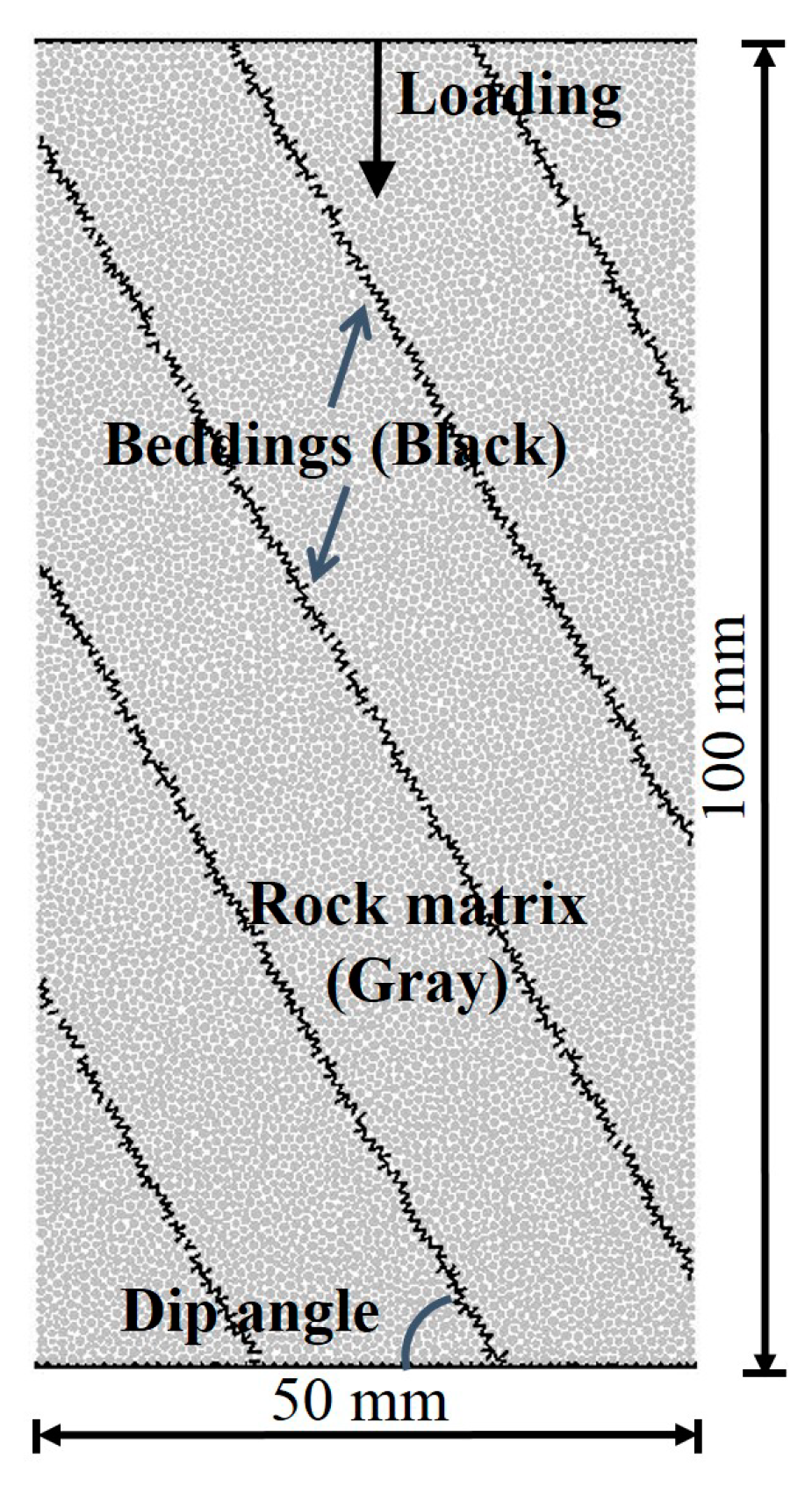
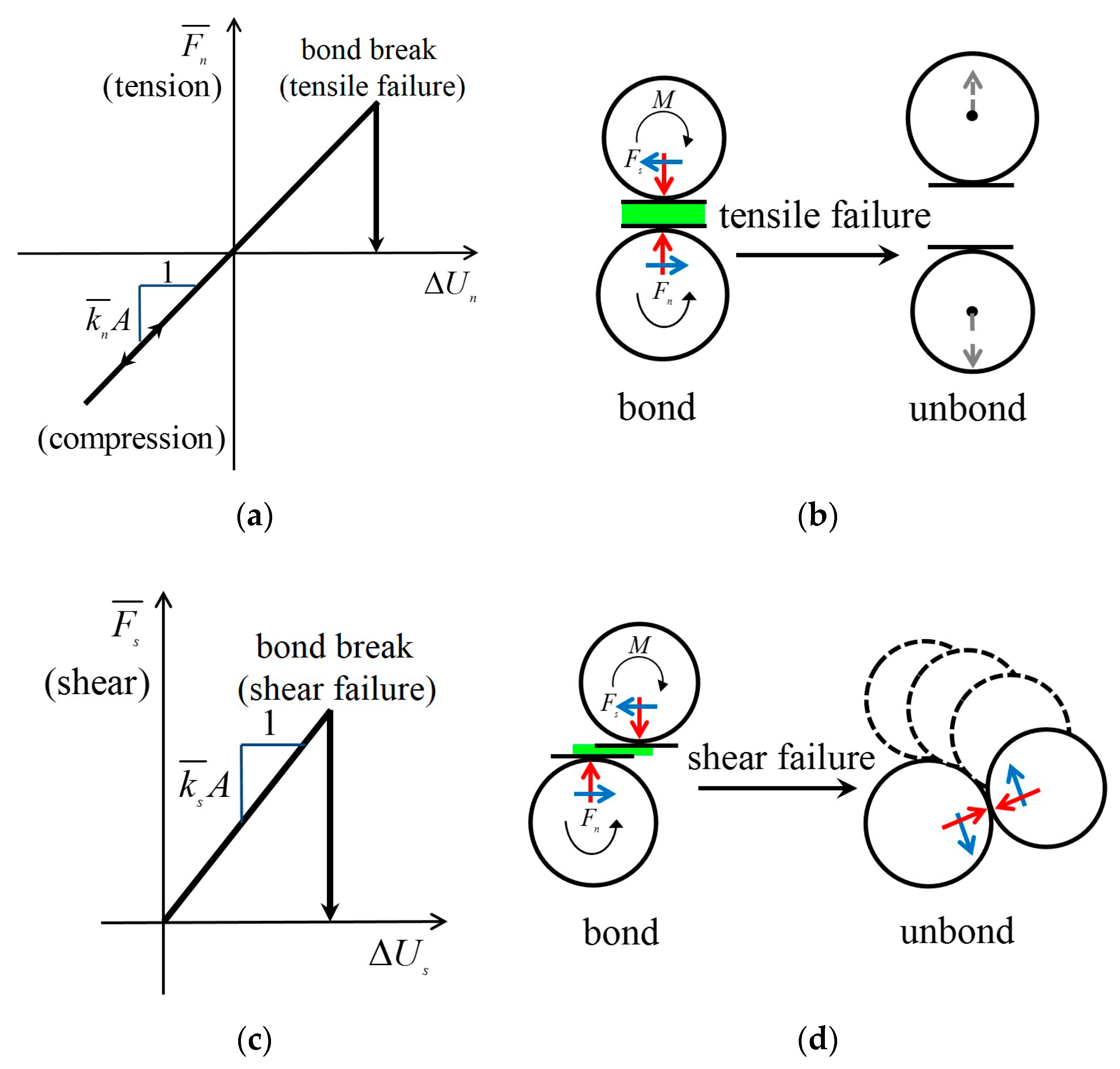
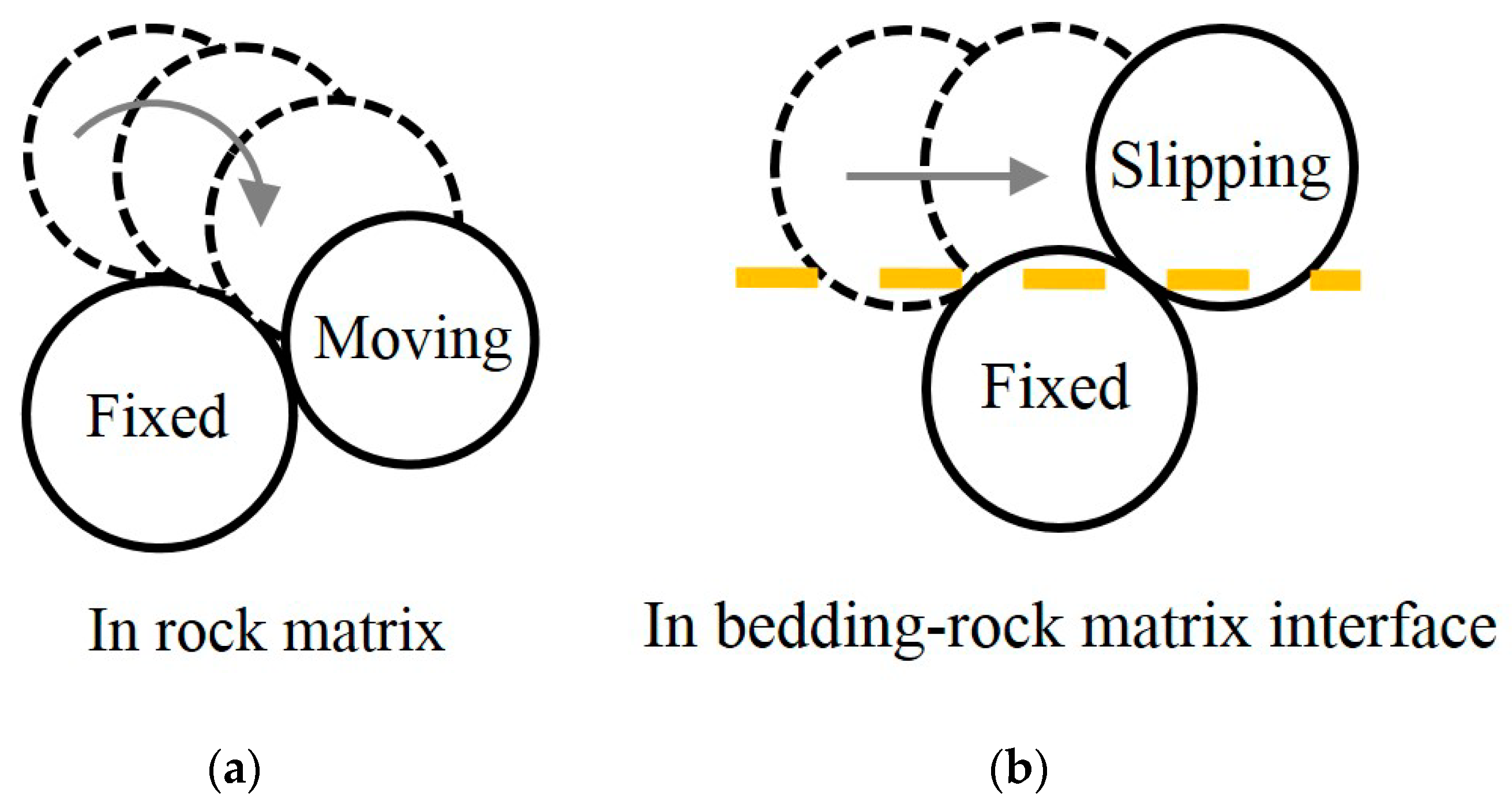
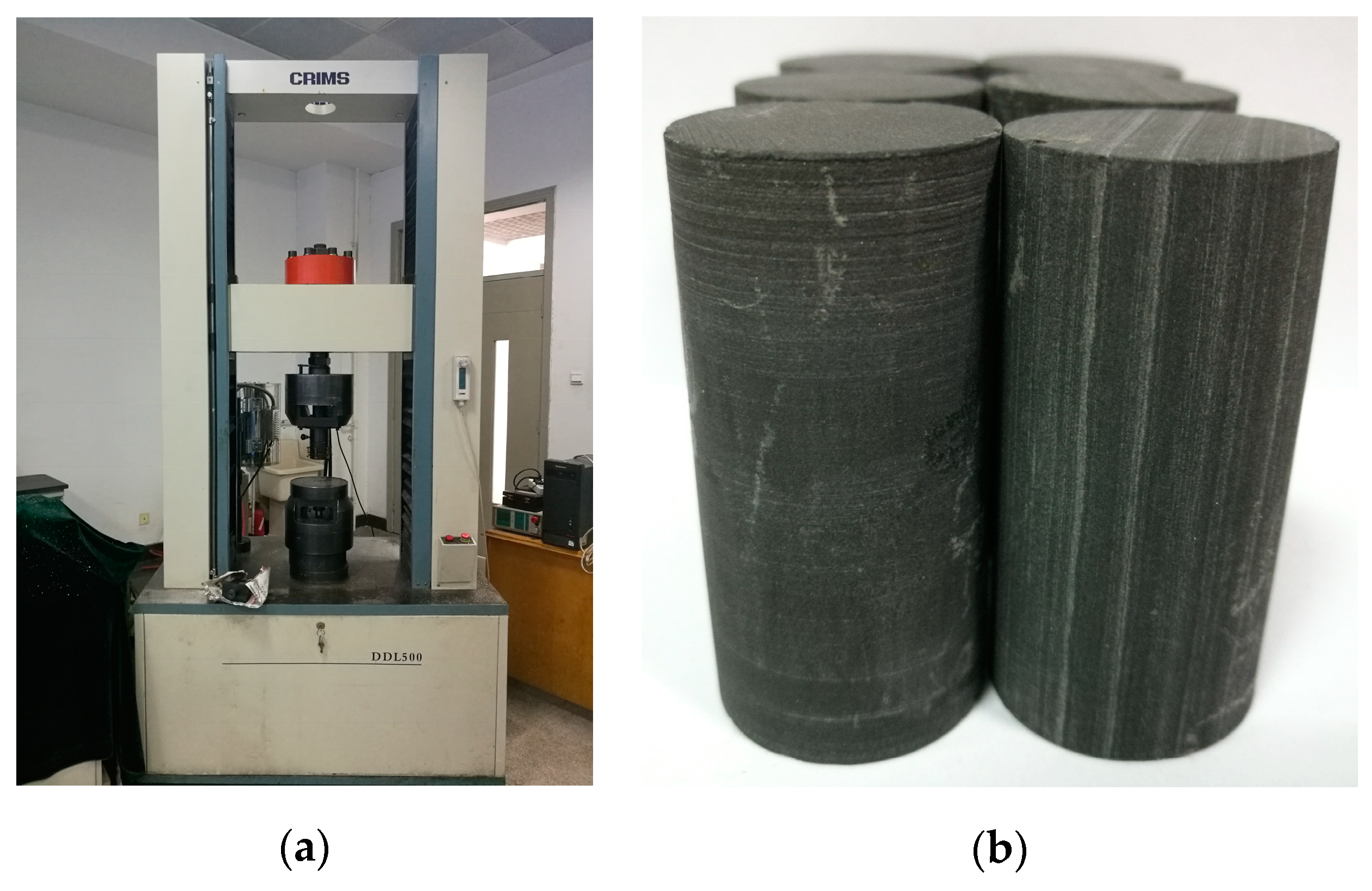
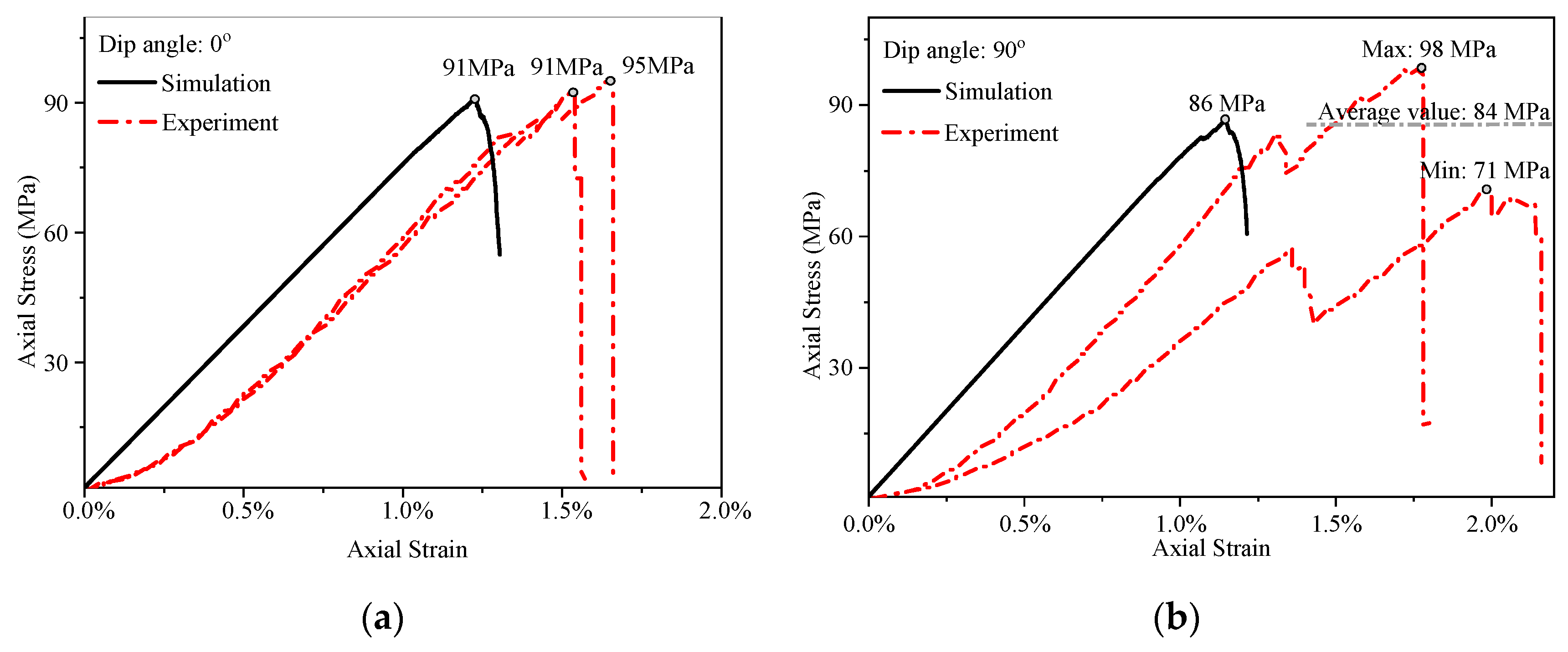
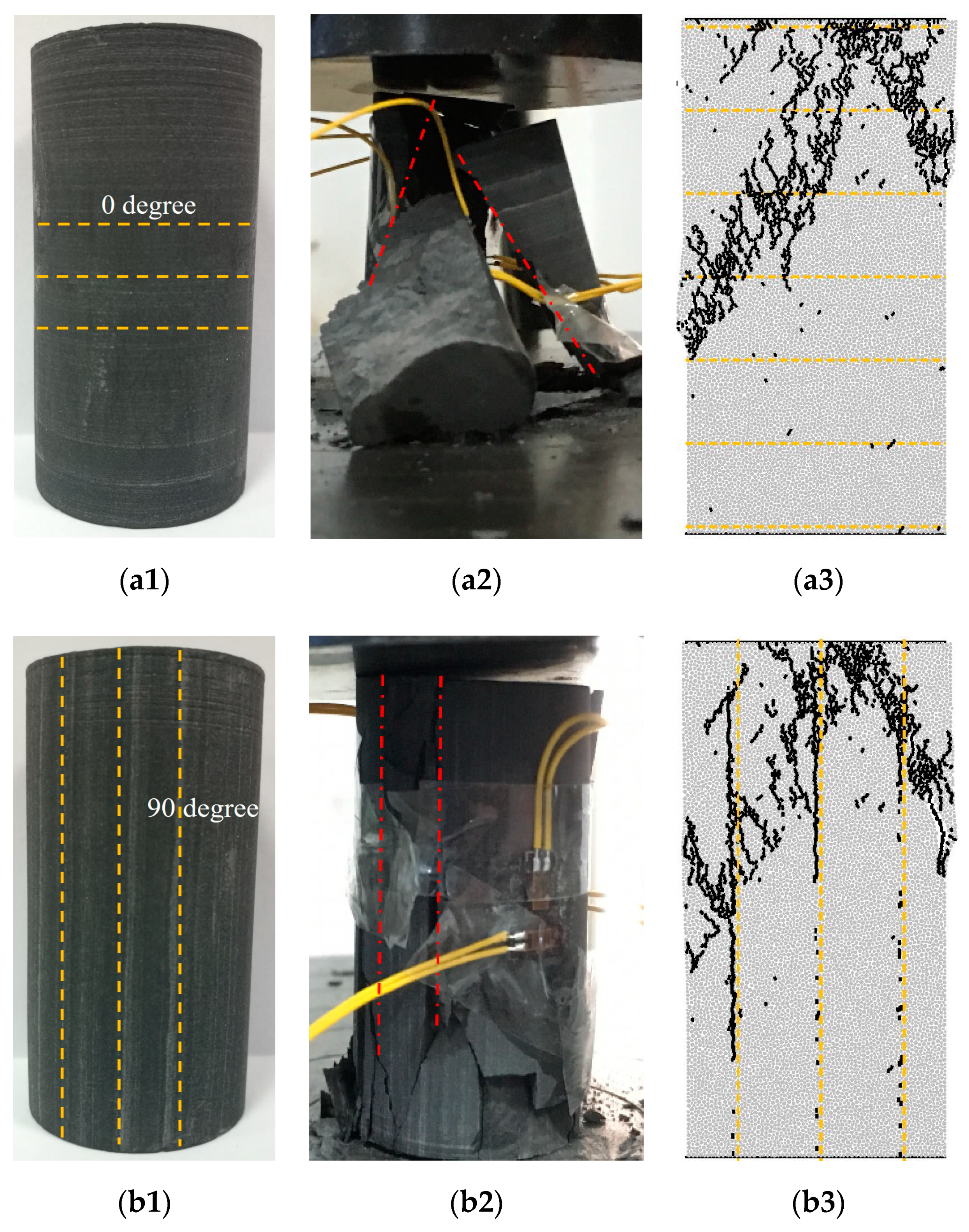
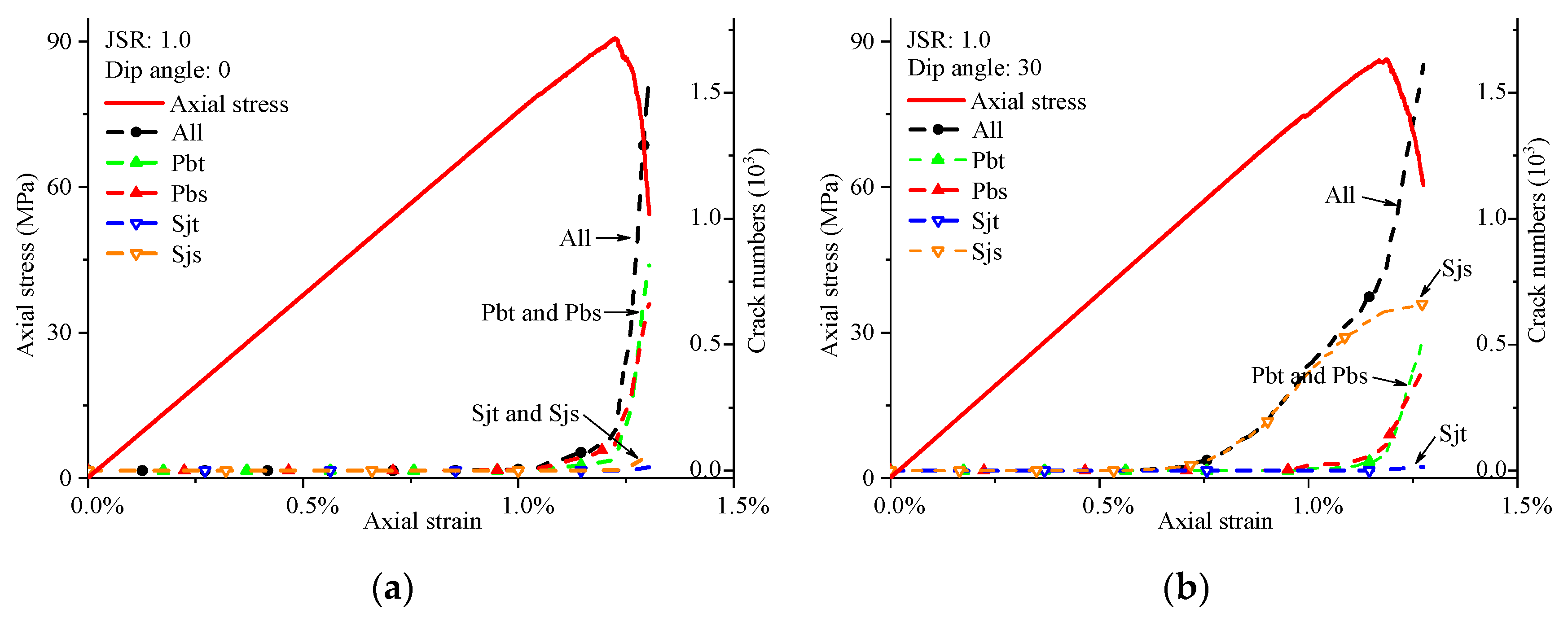
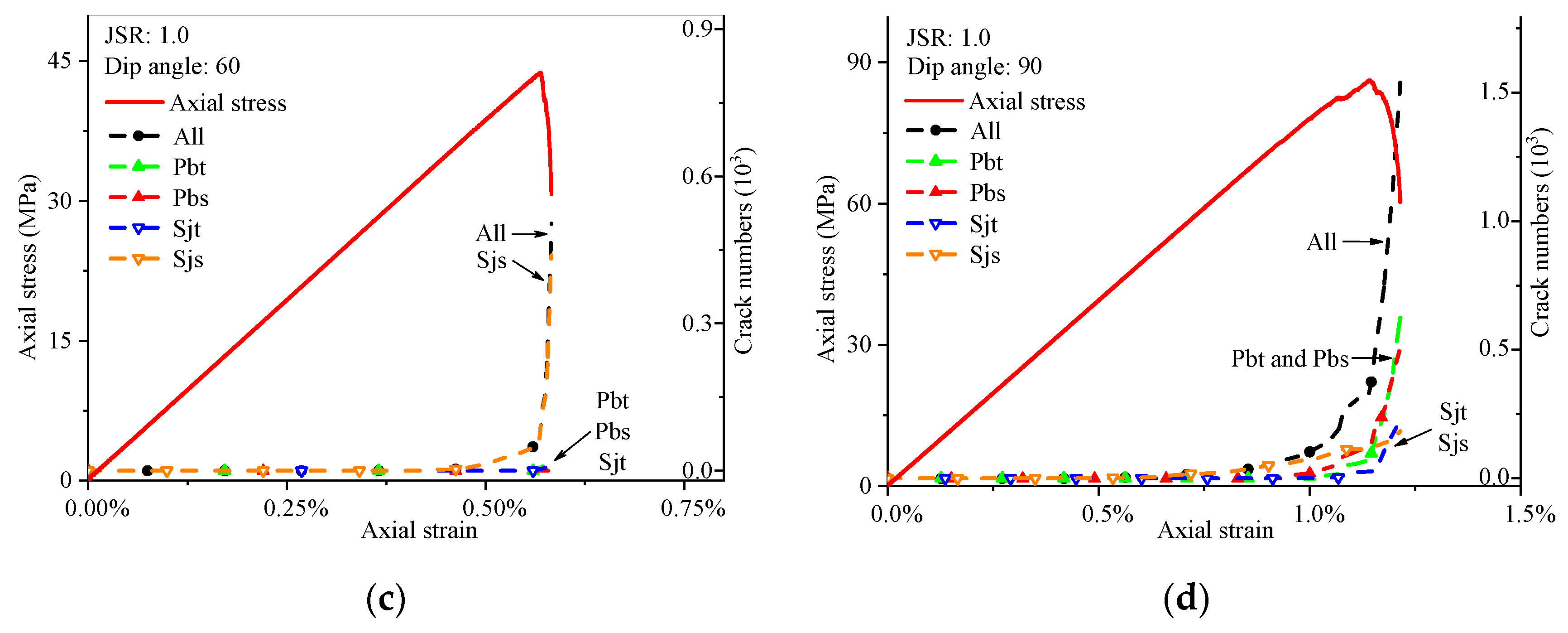

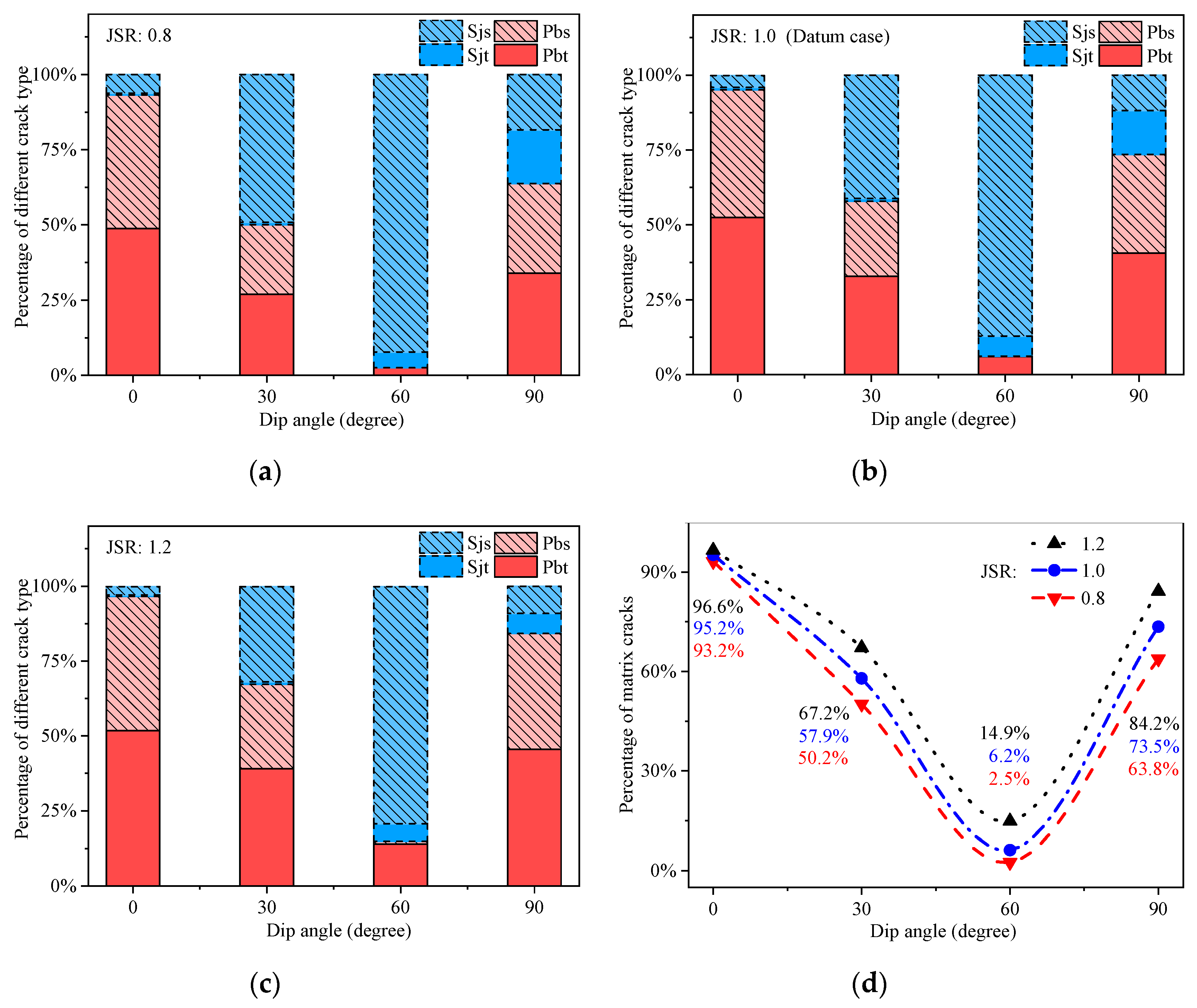
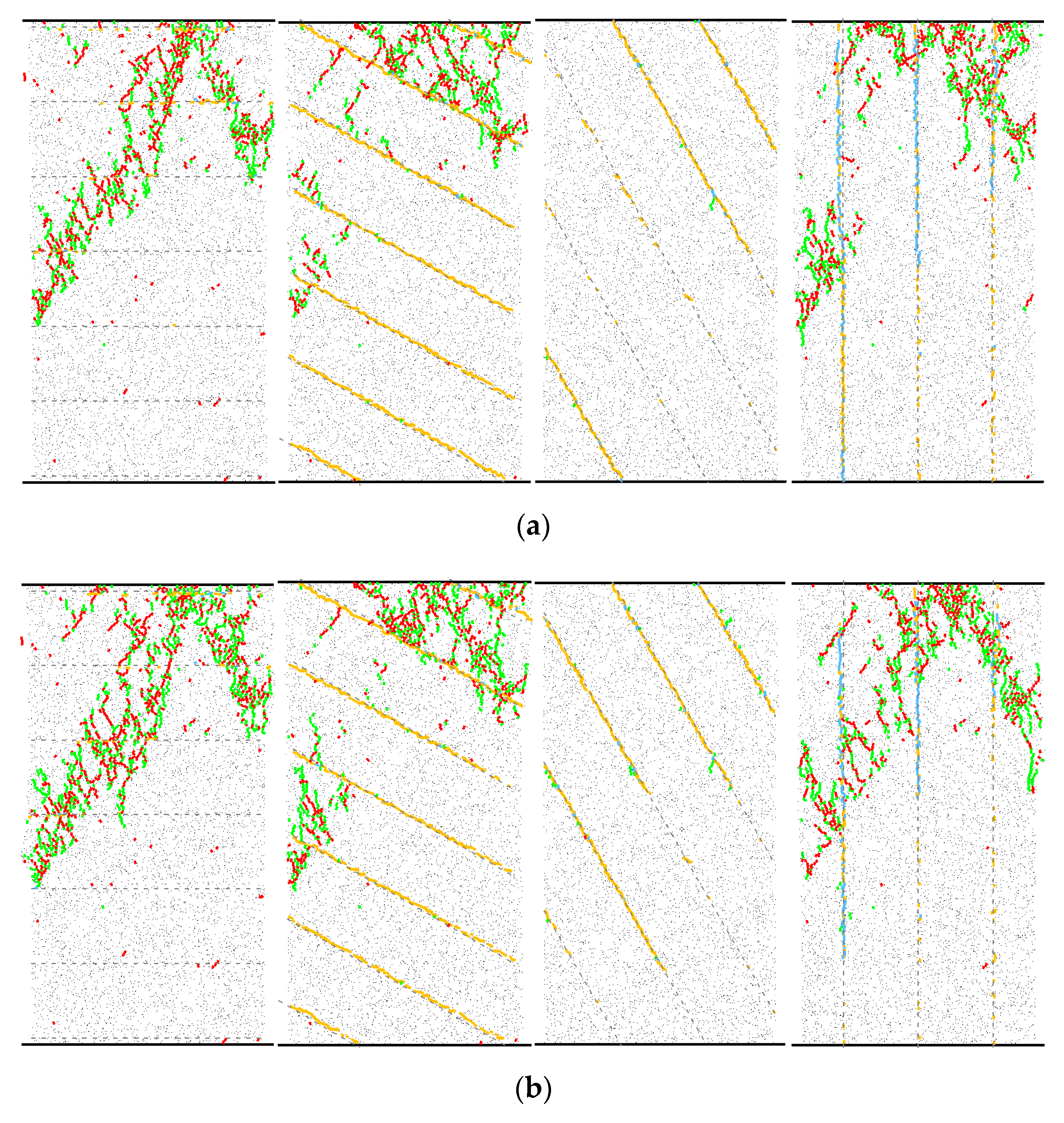
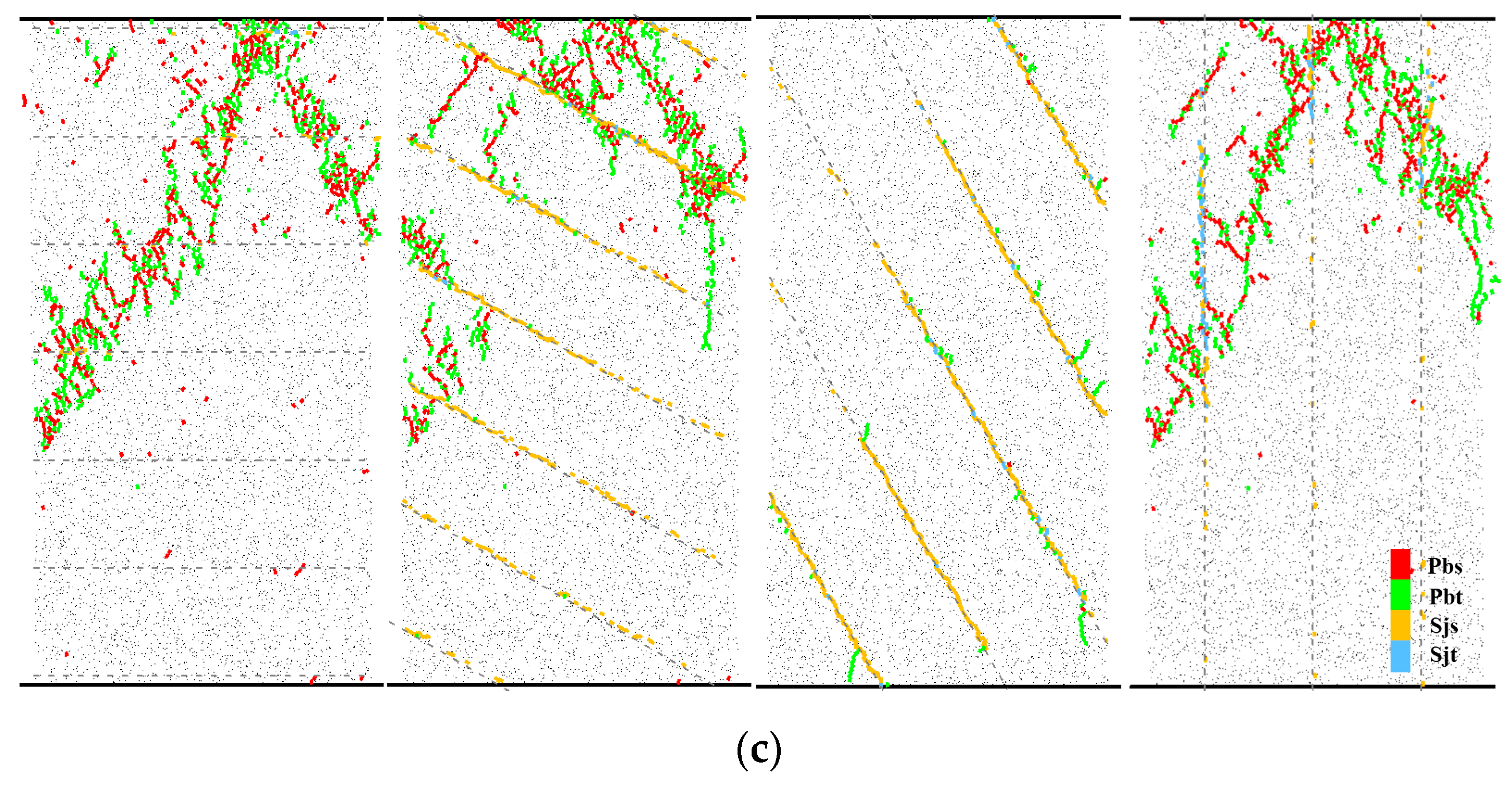
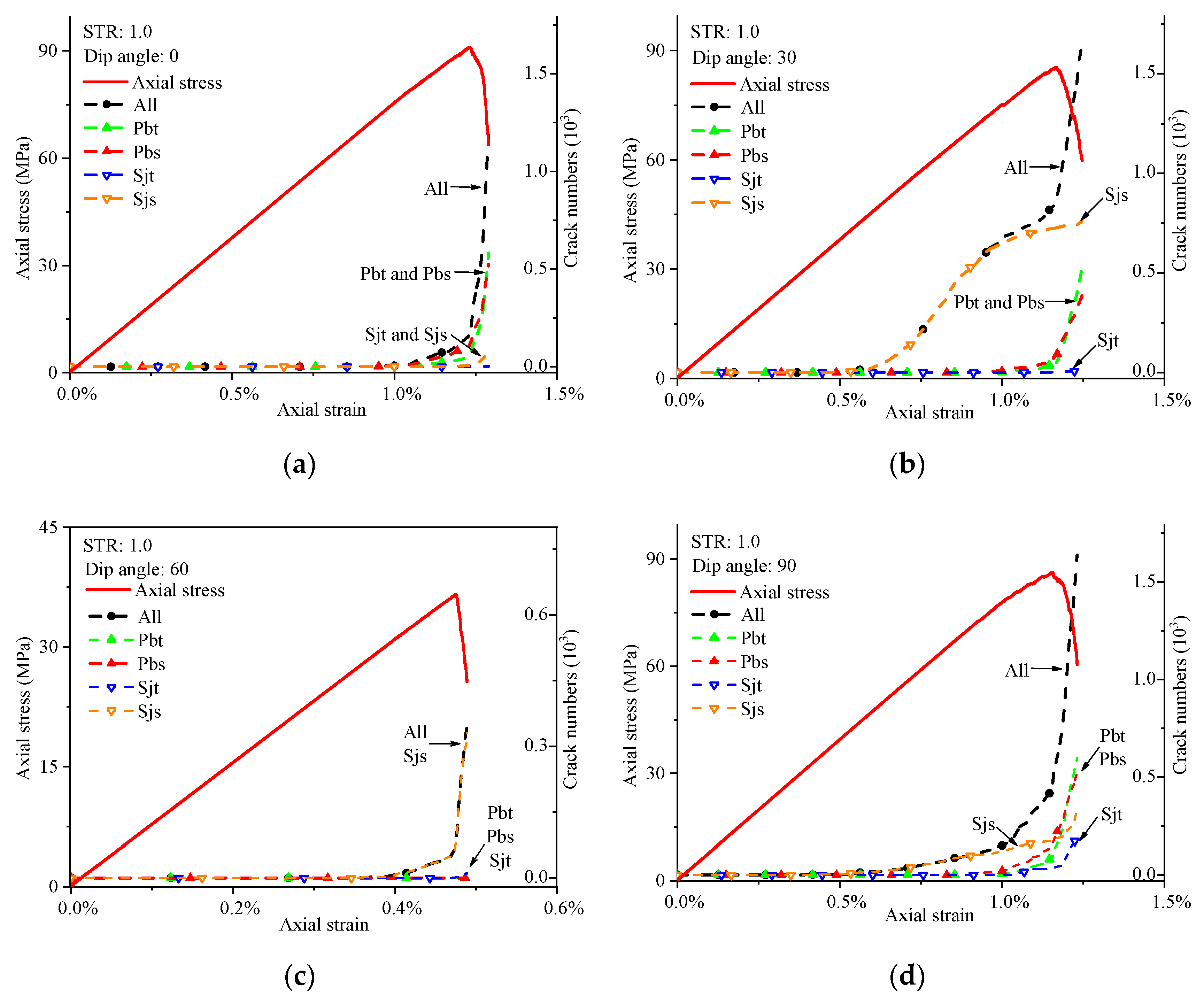
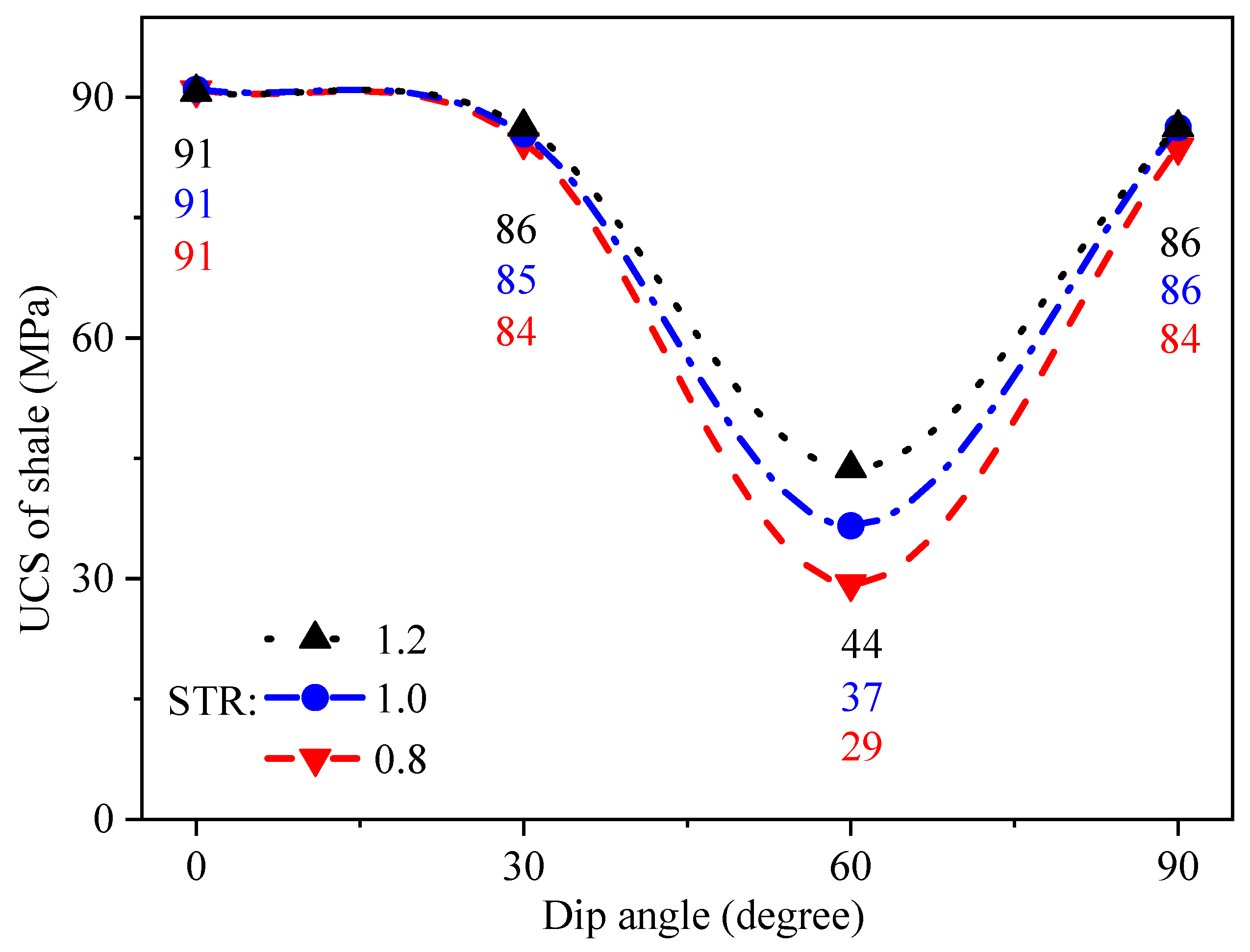
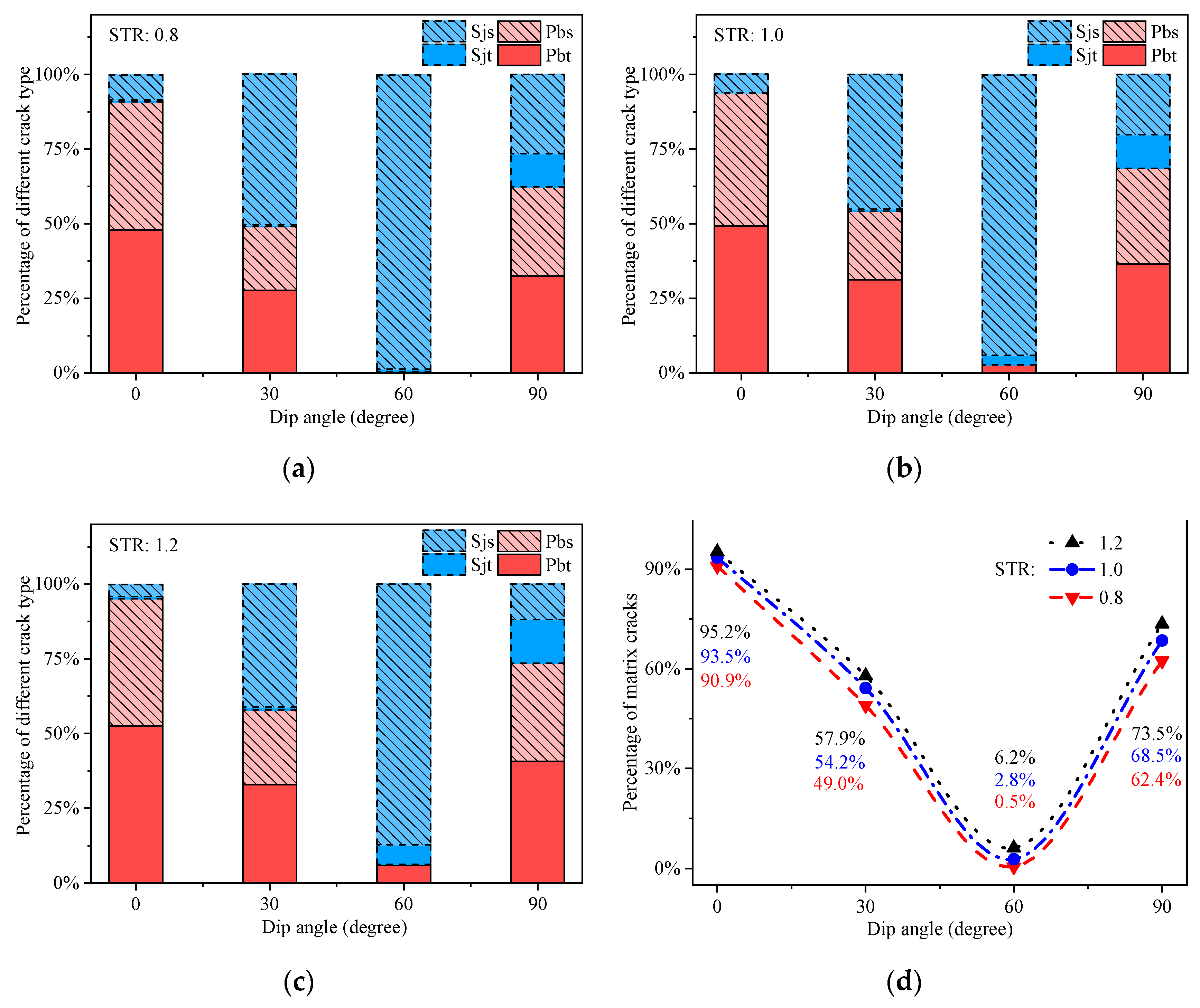
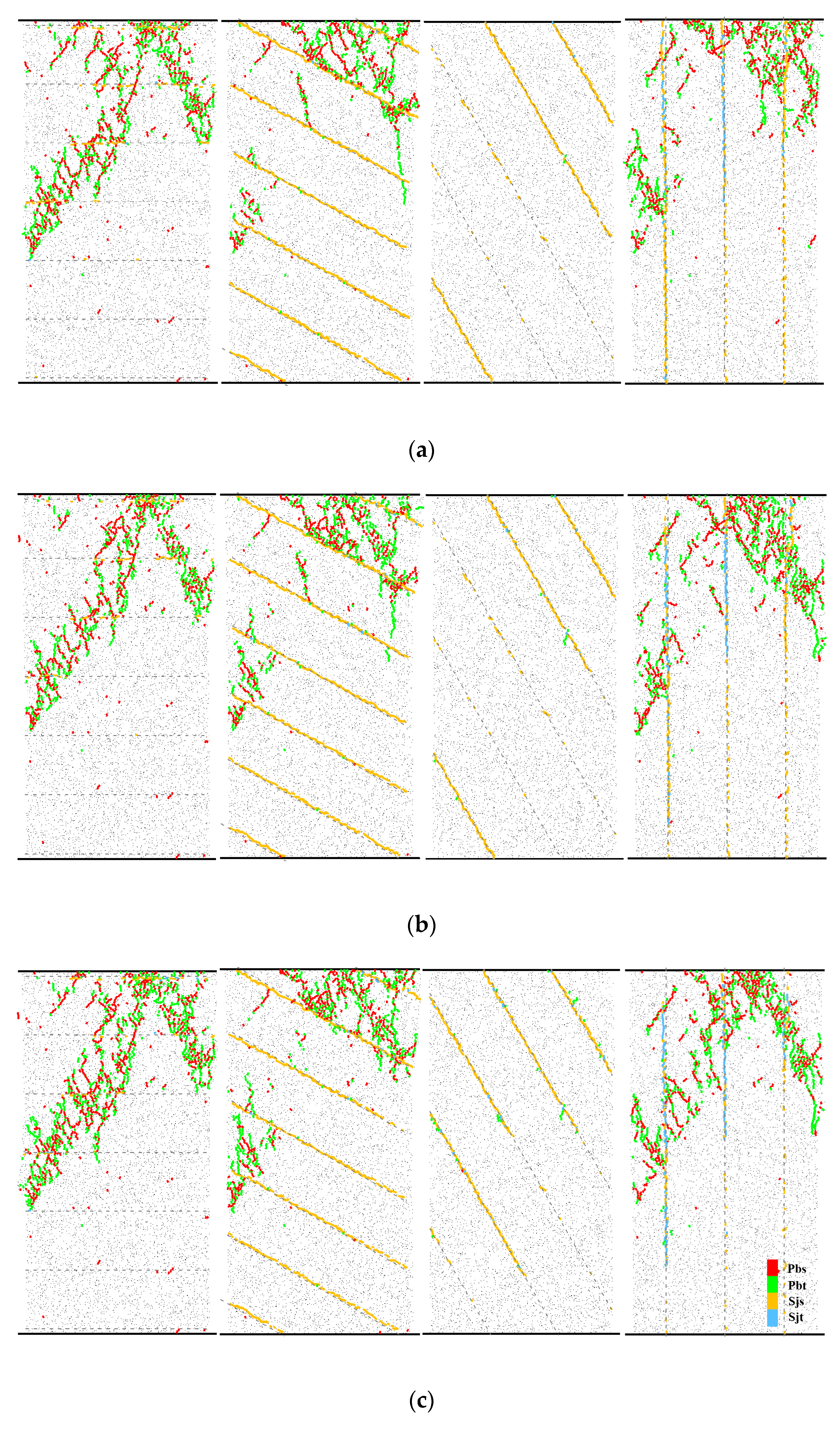

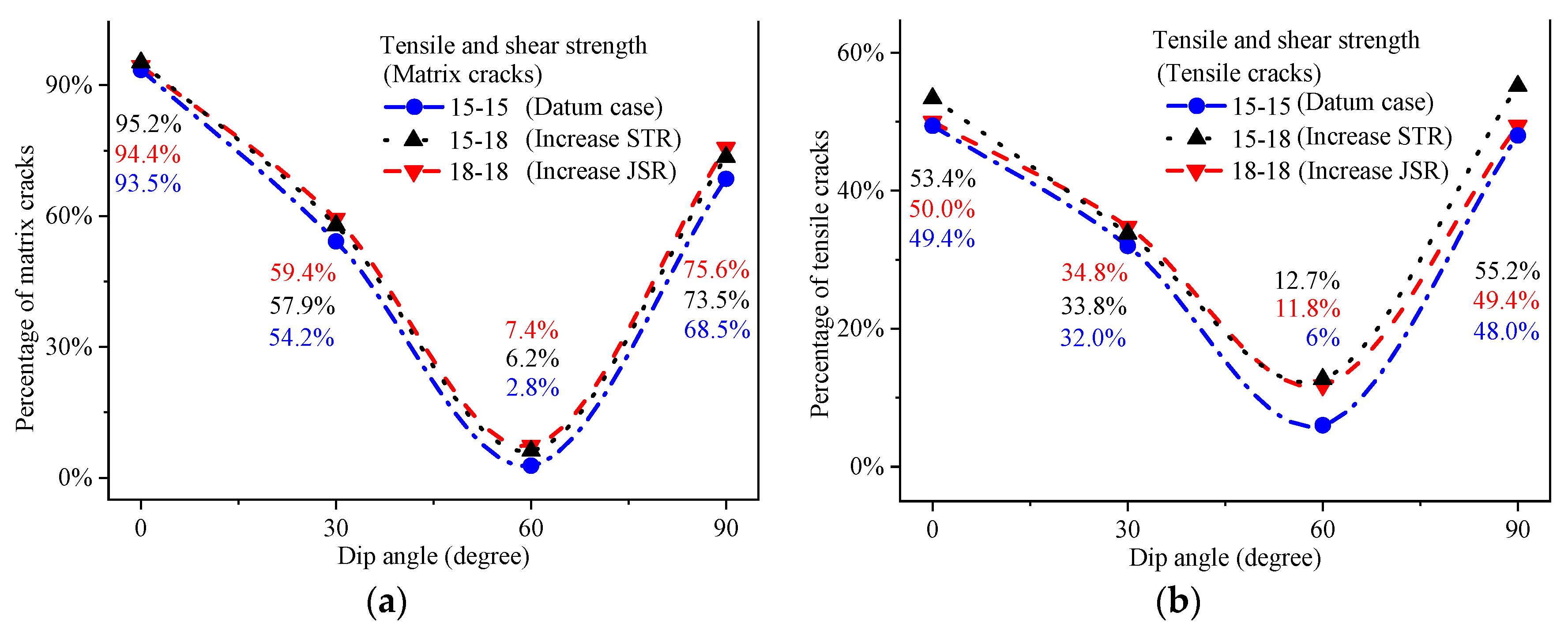
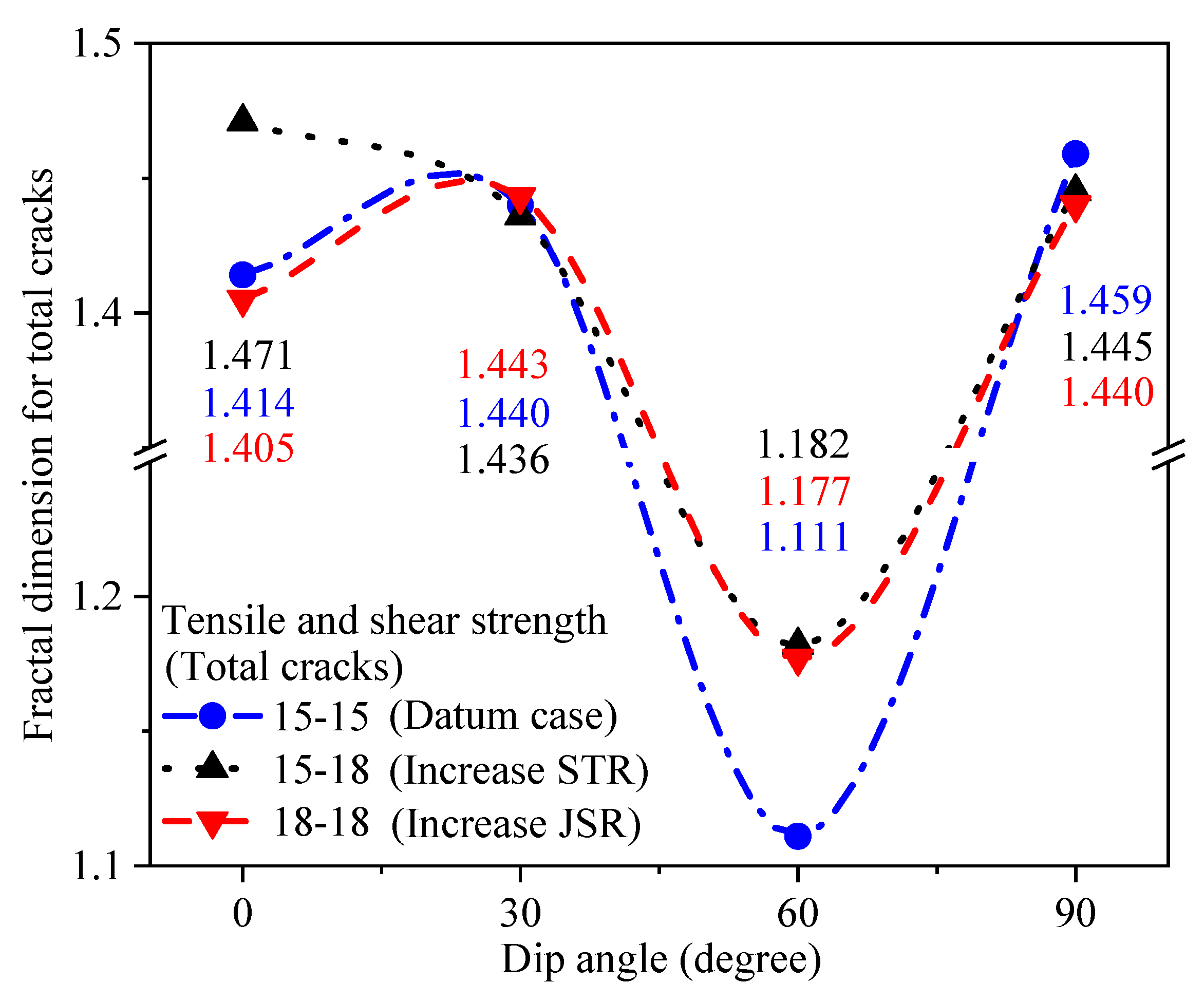
| Micro-Parameter | Value |
|---|---|
| Particle density (kg/m3) | 2330.0 |
| Young’s modulus of particle (GPa) | 4.0 |
| Young’s modulus of matrix (GPa) | 4.0 |
| Moment contribution factor | 0.2 |
| Ratio of normal to shear stiffness of particle | 1.8 |
| Ratio of normal to shear stiffness of matrix | 1.8 |
| Particle friction coefficient | 0.7 |
| Tensile strength (MPa) | 26.0 |
| Shear strength (MPa) | 32.5 |
| Micro-Parameter | Value |
|---|---|
| Normal stiffness (GPa/m) | 3000.0 |
| Shear stiffness (GPa/m) | 2000.0 |
| Tensile strength (MPa) | 15.0 |
| Shear strength (MPa) | 18.0 |
| Friction coefficient of beddings | 0.6 |
| Dilation angle (degree) | 20.0 |
| Type | Total Cracks | Matrix Cracks | Tensile Cracks | |
|---|---|---|---|---|
| Datum case | = 15 MPa = 15 MPa | 1.356 | 1.219 | 1.242 |
| Increase STR | = 15 MPa = 18 MPa | 1.383 | 1.268 | 1.293 |
| Increase JSR | = 18 MPa = 18 MPa | 1.366 | 1.263 | 1.282 |
© 2020 by the authors. Licensee MDPI, Basel, Switzerland. This article is an open access article distributed under the terms and conditions of the Creative Commons Attribution (CC BY) license (http://creativecommons.org/licenses/by/4.0/).
Share and Cite
Dou, F.; Wang, J.; Leung, C. The Impacts of Bedding Strength Parameters on the Micro-Cracking Morphology in Laminated Shale under Uniaxial Compression. Appl. Sci. 2020, 10, 5496. https://doi.org/10.3390/app10165496
Dou F, Wang J, Leung C. The Impacts of Bedding Strength Parameters on the Micro-Cracking Morphology in Laminated Shale under Uniaxial Compression. Applied Sciences. 2020; 10(16):5496. https://doi.org/10.3390/app10165496
Chicago/Turabian StyleDou, Fakai, Jianguo Wang, and Chunfai Leung. 2020. "The Impacts of Bedding Strength Parameters on the Micro-Cracking Morphology in Laminated Shale under Uniaxial Compression" Applied Sciences 10, no. 16: 5496. https://doi.org/10.3390/app10165496
APA StyleDou, F., Wang, J., & Leung, C. (2020). The Impacts of Bedding Strength Parameters on the Micro-Cracking Morphology in Laminated Shale under Uniaxial Compression. Applied Sciences, 10(16), 5496. https://doi.org/10.3390/app10165496






